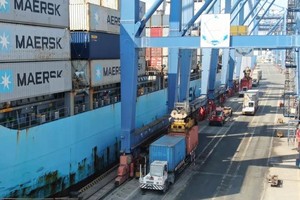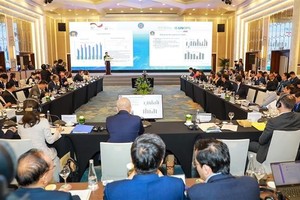Core inflation remained elevated, at 4.5 percent in May, compared to 4.6 percent in April.
The report said retail sales continued to expand at 11.5 percent annually in May, comparable to growth rates in the two previous months. Sales of goods improved from 9.7 percent in April to 10.9 percent in May.
 |
Illustrative image (Photo: VNA) |
Meanwhile, the sales of services declined from 19.2 percent in April to 7.6 percent in May. Although exports of goods increased by 4.3 percent between April and May, it was still 6 percent lower than a year ago due to weak external demand.
Imports fell by 18.4 percent in May, reflecting continued slowdown in demand for foreign inputs by both FDI and domestic firms. The continued contraction of imported inputs may indicate that producers expect weak export performance in the coming months.
FDI disbursement registered US$1.8 billion in May, a slight improvement from April, and comparable to a year earlier. To support the economy, the State Bank of Vietnam (SBV) cut policy rates for the third time since March.
Refinancing interest rate was reduced from 5.5 percent to 5 percent and overnight lending facility rate from 6 percent to 5.5 percent. Credit growth continued to decelerate from 9.2 percent in April to 9 percent in May, reflecting slack credit demand.
The monthly budget balance registered a large deficit of about 2 billion USD last month. Revenue collection continued to decrease by 35.8 percent, reflecting base effects due to high revenue from sales of land and property. Meanwhile, public expenditure also increased by 27.8 percent year-on-year in May.
The WB said continued weak external demand and uncertainties are adversely affecting the economy, translating into contraction in exports and imports, and a slowdown in industrial production. While investment disbursement (proxied by retail sales) remains robust and comparable to pre-pandemic levels, credit growth continues to slow, reflecting weak credit demand.
If global financial conditions tighten more, external demand may weaken further. Northern Vietnam started experiencing brownouts in late May, which, if not addressed promptly, could impact the economy.
As inflation appears to be tapering, the SBV eased monetary policies to support the economy. However, monetary policy authorities will need to closely monitor divergence in the monetary policy stance between Vietnam and other countries as it is creating pressures on capital flows and exchange rate.
Accelerating public investment disbursement (including for National Target Programs) would support aggregate demand and economic growth in the short run. At the same time, prioritising investments in digital and green technologies, infrastructure, and in human capital will help promote sustainable long-term development.
As manufacturing exports have slowed and employment in manufacturing has been affected, it would be important to quickly identify and support impacted workers and families through the social protection system. Streamlining administrative procedures and removing regulatory hurdles will help promote business activities and investments needed for economic growth, it added.
























